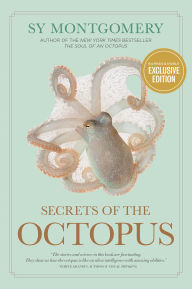Octopus Time: A Guest Post by Sy Montgomery
Sy Montgomery wowed the world with her first octopus book, Soul of an Octopus, and now she returns to the same subject. Utilizing the insights of experts in the field, this is a fresh new look at one of the most fascinating creatures on the planet, all from someone who knows them dearly. Read on for an exclusive essay from Sy on writing Secrets of the Octopus.
Secrets of the Octopus (B&N Exclusive Edition)
Secrets of the Octopus (B&N Exclusive Edition)
By Sy Montgomery , Warren K. Carlyle IV
In Stock Online
Paperback
$13.50
$18.00
Learn from an international bestselling author, the world’s brightest octopus researchers, and vivid National Geographic photography to come closer than ever to these elusive creatures.
Learn from an international bestselling author, the world’s brightest octopus researchers, and vivid National Geographic photography to come closer than ever to these elusive creatures.
We called it “Octopus Time.” Our hands and forearms submerged in the 47 degree water of our friend Octavia’s saltwater tank, we would stroke and pet her silky, custardy arms, watching her skin change color as she gently kissed our flesh with her soft, supple suckers. This is what it felt like being friends with a Giant Pacific Octopus: as if time stretched to eternity, and the half a billion years of evolution that separated the ancestors of my terrestrial kin and her cephalopod ancestors had collapsed into this magical moment.

These languid, tranquil, magical afternoons—and during my three years regularly working with octopuses at the New England Aquarium, there were many—taught me a great deal about the connections that are possible between different species. Octopuses clearly recognize individual humans, which has been demonstrated by laboratory experiments, and they prefer some people to others. They move away from those they don’t like, sometimes first blasting them in the face with cold salt water shot from the tube they use to jet through the sea. Octopuses clearly enjoy the company of some people, and will leave their lair, initially turning red with excitement, to join these valued human visitors. With other staffers and volunteers at the aquarium, I fed, played with, and stroked a number of octopuses who clearly recognized us and obviously relished our interactions.

I wrote about these relationships in The Soul of an Octopus: A Surprising Exploration into the Wonder of Consciousness. But my experiences also left me with many questions, including this central one: why would an animal as famously solitary as an octopus even want to spend time with me?
A few years later, I got the opportunity to find out. National Geographic offered me the chance to research and write Secrets of the Octopus, which would accompany a three-part TV special of the same name. I was free to explore the new research that had exploded since the 2015 publication of my book—discoveries so revealing that most researchers agree we are now living in a “Golden Age” of octopus science.
I spoke extensively with the world’s top octopus scientists. I interviewed researchers investigating whether octopuses dream (they appear to, though scientists are loathe to apply the word to non-human subjects). I talked with scientists investigating octopus camouflage, octopus senses, octopus sex. Many were cataloging new species of octopus. And I spoke with divers and filmmakers—including those gathering footage for the TV series–who were recording behaviors never before documented.

Some of the new discoveries were thrillingly strange. For instance, octopuses can rewrite their own RNA—the messenger molecules that direct gene expression—which may help account for their extraordinary ability to learn so much so fast during their too-short lives. Other discoveries affirmed my own experience. Why would a solitary animal like an octopus accept a human as a friend? As it turns out, octopuses are not so solitary as previously thought. Each species is different, but a growing number can and do live in association with other octopuses—and several have been seen associating with individuals of other species—fish, for instance—as regular, trusted hunting partners. And, who knows, maybe even as friends.

